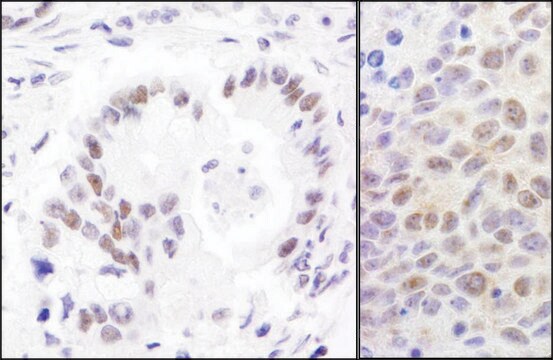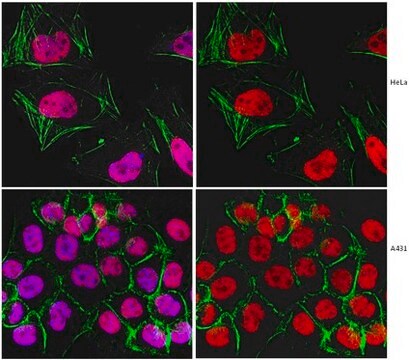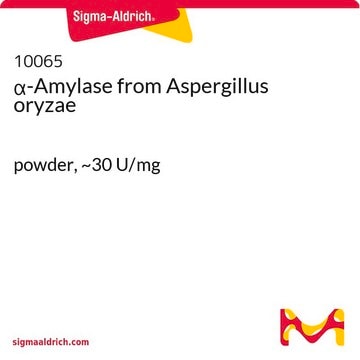추천 제품
생물학적 소스
mouse
Quality Level
항체 형태
purified antibody
항체 생산 유형
primary antibodies
클론
RPA70-9, monoclonal
형태
liquid
포함
≤0.1% sodium azide as preservative
종 반응성
human, yeast
제조업체/상표
Calbiochem®
저장 조건
do not freeze
동형
IgG2a
배송 상태
wet ice
저장 온도
2-8°C
타겟 번역 후 변형
unmodified
유전자 정보
human ... RPA1(6117)
일반 설명
Purified mouse monoclonal antibody generated by immunizing BALB/c mice with the specified immunogen and fusing splenocytes with the NS1 myeloma cell line. Recognizes the ~70 kDa Replication Protein A.
Recognizes the ~70 kDa subunit of replication protein A in HeLa and u293 cells and colon carcinoma tissue.
This Anti-Replication Protein A (Ab-1) Mouse mAb (RPA70-9) is validated for use in Frozen Sections, Immunoblotting, IF, IP, Paraffin Sections for the detection of Replication Protein A (Ab-1).
면역원
Epitope: Within the p70 subunit of replication protein A
Human
replication protein A purified from U293 cells
애플리케이션

Frozen Sections (2.5 g/ml)
Immunoblotting (1-5 g/ml)
Immunofluorescence (2.5 g/ml)
Immunoprecipitation (1 g/reaction)
Paraffin Sections (2.5 g/ml, no pre-treatment required)
포장
Please refer to vial label for lot-specific concentration.
경고
Toxicity: Standard Handling (A)
물리적 형태
In 0.05 M sodium phosphate buffer, 0.2% gelatin.
분석 메모
Positive Control
HeLa or U293 cells or colon carcinoma tissue
HeLa or U293 cells or colon carcinoma tissue
기타 정보
Din, S., et al. 1990. Genes Dev.4, 968.
Brill, S.J. and Stillman, B., 1989. Nature342, 92.
Stillman, B., 1989. Annu. Rev. Cell. Biol.5, 197.
Tsurimoto, T. and Stillman, B., 1989. EMBO J.8, 3883.
Wobbe, C.R., et al. 1987. Proc. Natl. Acad. Sci. USA84, 1834.
Brill, S.J. and Stillman, B., 1989. Nature342, 92.
Stillman, B., 1989. Annu. Rev. Cell. Biol.5, 197.
Tsurimoto, T. and Stillman, B., 1989. EMBO J.8, 3883.
Wobbe, C.R., et al. 1987. Proc. Natl. Acad. Sci. USA84, 1834.
Specific for the p70 subunit of replication protein A. This antibody can be used as a marker for proliferation. Antibody should be titrated for optimal results in individual systems.
법적 정보
CALBIOCHEM is a registered trademark of Merck KGaA, Darmstadt, Germany
Not finding the right product?
Try our 제품 선택기 도구.
Storage Class Code
11 - Combustible Solids
WGK
WGK 1
Flash Point (°F)
Not applicable
Flash Point (°C)
Not applicable
시험 성적서(COA)
제품의 로트/배치 번호를 입력하여 시험 성적서(COA)을 검색하십시오. 로트 및 배치 번호는 제품 라벨에 있는 ‘로트’ 또는 ‘배치’라는 용어 뒤에서 찾을 수 있습니다.
S Buchsbaum et al.
Oncogene, 26(35), 5132-5144 (2007-02-22)
The mouse int6 gene is a frequent integration site of the mouse mammary tumor virus and INT6 silencing by RNA interference in HeLa cells causes an increased number of cells in the G2/M phases of the cell cycle, along with
Tom Stiff et al.
Human molecular genetics, 25(8), 1574-1587 (2016-02-26)
Mutations in ATR(ataxia telangiectasia and RAD3-related) cause Seckel syndrome (ATR-SS), a microcephalic primordial dwarfism disorder. Hitherto, the clinical manifestation of ATR deficiency has been attributed to its canonical role in DNA damage response signalling following replication fork stalling/collapse. Here, we
Laurent Miccoli et al.
Molecular and cellular biology, 25(9), 3814-3830 (2005-04-16)
The human stress-activated protein kin17 accumulates in the nuclei of proliferating cells with predominant colocalization with sites of active DNA replication. The distribution of kin17 protein is in equilibrium between chromatin-DNA and the nuclear matrix. An increased association with nonchromatin
Francis Rodier et al.
Journal of cell science, 124(Pt 1), 68-81 (2010-12-02)
DNA damage can induce a tumor suppressive response termed cellular senescence. Damaged senescent cells permanently arrest growth, secrete inflammatory cytokines and other proteins and harbor persistent nuclear foci that contain DNA damage response (DDR) proteins. To understand how persistent damage
Ken-ichi Yoshioka et al.
Molecular cell, 22(4), 501-510 (2006-05-23)
S(N)1-type alkylating agents that produce cytotoxic O(6)-methyl-G (O(6)-meG) DNA adducts induce cell cycle arrest and apoptosis in a manner requiring the DNA mismatch repair (MMR) proteins MutSalpha and MutLalpha. Here, we show that checkpoint signaling in response to DNA methylation
자사의 과학자팀은 생명 과학, 재료 과학, 화학 합성, 크로마토그래피, 분석 및 기타 많은 영역을 포함한 모든 과학 분야에 경험이 있습니다..
고객지원팀으로 연락바랍니다.








